|
I am a Ph.D. Research Scholar working in Computer Vision. I am passionate about learning machine learning algorithms and solving practical challenges in their application to real-world problems. My research concentrates on the use of machine learning (especially Deep Learning) methods for activity recognition from videos. A deep learning architecture is proposed for egocentric video, which integrates both action appearance and motion within a single model. Development and evaluation will be based on publicly available data.
Email /
Google Scholar /
Researchgate /
Linkedin /
Github /
Twitter /
Medium / |

|
ResearchI'm interested in computer vision, deep learning, machine learning, image processing and video analysis. |

|
Publication Will be updated. |

|
Publication Will be updated. |

|
Publication A novel approach to noise profiling for artificial neural networks (ANNs) is proposed, which is inspired by the sensory systems of insects. This approach entails the utilization of both Gaussian and Chaotic noises to enhance the adaptability, learning and generalization capabilities of ANNs. |

|
project page / Publication Virtual laboratories are an essential part of E-learning because all the students in their institutes may not have sufficient lab facilities. These experiments can be accessed from anywhere and anytime. Therefore, the Ministry of Human Resource Development (MHRD), Govt. of India took an initiative of integration of virtual laboratories under the national mission on Education through Information and Communication Technology (NME-ICT) . The motive of virtual lab integration is to make all the developed projects into an open source repository such that all the lab information is available to a community, students as well as academic institutes, for use and development, to convert all licensed contents into a platform that is independent of any licensed software. |

|
Project page / Publication The Ministry of Human Resource Development (MHRD), Govt. of India took the initiative of Remote Triggered Digital System Laboratory under the National Mission on Education through Information and Communication Technology (NME-ICT). This virtual laboratory provides the theoretical understanding of digital electronics to the students by performing various experiments. |

|
Publication The Human Management System is a Java based (J2EE) system which provides intranet automation of HR software. The aim of the paper is based on a project that helps the overall management of the employees, who work in a company. The proposed system contains all the information regarding employees in the company. The system is developed on good interaction as well as communication facilities between the HR administrator and the working employees. |
|
|
Fun ProjectsFollowing are a collection of practice projects, which sparks my interest in further explorations. Github In this project, the goal was to train a Convolutional Neural Network (CNN) for regression prediction with Keras and then train a CNN to predict house prices from a set of images. Github The objective of the project was to create a deep learning model to classify images of clothing from the Fashion MNIST dataset. The Fashion MNIST dataset is a collection of grayscale images of 10 different categories of clothing and accessories, like T-shirts, trousers, pullovers, dresses, coats, sandals, shirts, sneakers, bags, and ankle boots. Github This project used Haar cascade face detector, extract the face region of interest (ROI) from the image and then pass the ROI through LeNet for smile detection. Github This project demonstrated how to use deep learning techniques, specifically with frameworks like Keras and TensorFlow, to automatically solve CAPTCHA challenges. Github This amied to use Early Stopping and Model Checkpointing in training Keras models encapsulates a sophisticated approach to deep learning. Github The project was designed to classify an image by identifying the main subject in the image, leveraging pre-trained deep learning models available through TensorFlow's Keras library. It accepts an image file and a model name as input parameters. The script supports various state-of-the-art image classification models like VGG16, VGG19, ResNet50, InceptionV3, and Xception, which have been trained on the ImageNet dataset. Github The goal was to visualize network architecture using Keras and TensorFlow. Github The goal was for building, training, evaluating, and plotting the performance of a convolutional neural network (LeNet) for digit classification on the MNIST dataset. Github The goal was to create the first deep learning neural network model in Python using Keras. Here, we started by loading and preparing our dataset, followed by defining and compiling a Keras neural network model. We trained the model on our data, evaluate its performance, and then use it to make predictions on new data. We used Pima Indians onset of diabetes dataset. Github We explored hands-on code that illustrates how to implement and apply convolution operations and kernels to images. This insight aided in understanding the internal workings of Convolutional Neural Networks (CNNs) during their training phase. Github Mastering Backpropagation: A Step-by-Step Guide to Implementing it with Python Github The project demonstrated how a perceptron model could learn bitwise operations through a basic machine learning process involving training with input features and corresponding labels, followed by testing to evaluate the model's predictions. Github This project explores pedestrian detection using four different computer vision techniques. Github This project showcased the implementation of Haar Cascade classifiers for object detection in video streams. Haar Cascades are a popular method for object detection due to their efficiency and effectiveness, particularly in detecting faces and other predefined objects. Using OpenCV, this project demonstrates how to apply Haar Cascades to real-time video data to identify and track objects. Github This project focused on counting fingers in a real-time video using OpenCV. Github The Smile Detection Project aimed at identifying smiles real-time video feeds using a facial landmark detector to accurately determine the presence of a smile. Github The Face Detection project aimed to identify and locate human faces within a digital image utilizing Haar Cascades. Github These project series provides an essential overview of computer vision techniques using OpenCV. It begins with fundamental image operations—loading, displaying, and pixel manipulation—then advances to drawing, translation, rotation, resizing, flipping, and cropping. Additionally, it explores arithmetic operations, bitwise manipulations, masking, and channel manipulation. Accompanied by downloadable source code for each tutorial, this series offers a practical and efficient way to grasp the key functionalities of OpenCV, making it perfect for beginners eager to learn quickly. |
 https://orcid.org/0009-0007-6149-789X
https://orcid.org/0009-0007-6149-789X